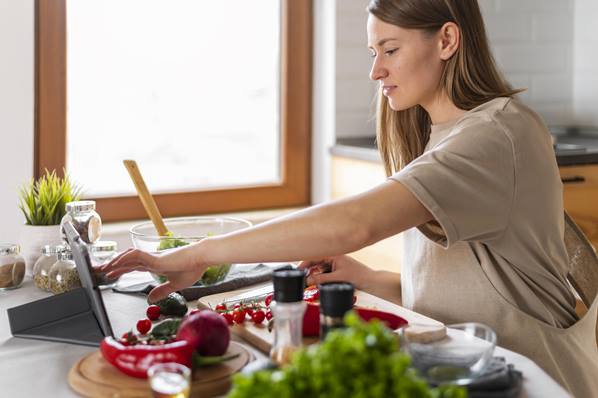
Achieving consistency in the kitchen is a skill every home cook aspires to master. From novice chefs to seasoned professionals, everyone benefits from proven techniques that lead to reliable, delicious results. Whether you’re experimenting with new recipes or perfecting classic dishes, there are key strategies you can adopt to ensure every meal turns out exactly how you want it. Let’s dive into some expert-backed tips that will help you master your kitchen.
Start with Proper Preparation
Preparation is the foundation of any successful cooking experience. It’s not just about having the right ingredients but also making sure you have the right tools. Before you even turn on the stove, be sure to read through your recipe thoroughly. Make note of any ingredients that need to be prepared in advance, whether it’s chopping vegetables or marinating meats. A well-prepared kitchen is a stress-free kitchen, allowing you to move smoothly from one task to the next without missing a beat.
In addition, ensure that you have the essential equipment to make cooking more efficient. From sharp knives to quality cookware, the right tools make all the difference. For instance, if you’re whipping up desserts, having access to a high-quality cream charger can elevate your presentations, making it easier to create perfect whipped cream toppings.
Understand Your Ingredients
Every ingredient you use plays a specific role in your dish. To truly master the kitchen, it’s essential to understand the science behind the ingredients. For instance, fats add richness, while acids balance flavors, and heat can either tenderize or toughen your food depending on how it’s applied. Take the time to research the characteristics of your ingredients. This knowledge will allow you to make informed substitutions when necessary and create a balance of flavors and textures.
Pay close attention to seasonal produce as well. Fresh ingredients, such as vegetables and herbs, are packed with more flavor when they’re in season, which can transform a simple dish into something extraordinary. If you need inspiration for using seasonal produce, reliable news sites like BBC Good Food often provide guides and updates on what’s fresh and how to use it creatively in your kitchen.
Control Your Heat and Timing
The difference between a well-cooked meal and a burned disaster often comes down to how you manage heat and timing. Each stage of cooking has its ideal temperature and duration. Understanding when to use high heat versus low heat can prevent overcooking or undercooking your food. For example, searing meat on high heat helps lock in the juices, but slow-cooking it at a lower temperature afterward ensures it’s tender and flavorful.
Use timers religiously, especially if you’re multitasking. Even experienced chefs rely on precise timing to avoid mishaps. If you’re trying a new technique, start slow and gradually build your confidence. Remember, perfecting temperature control is a crucial aspect of mastering the kitchen.
Taste as You Go
The best way to avoid bland or overly salty dishes is to taste your food throughout the cooking process. Seasoning gradually allows you to adjust flavors to your preference. This is particularly important for complex dishes, where multiple layers of flavor come together. Trust your taste buds and adjust ingredients accordingly—whether it’s adding a pinch of salt, a squeeze of lemon juice, or a dash of spice.
It’s also helpful to familiarize yourself with different cuisines and flavor profiles. Experimenting with international ingredients and techniques can broaden your cooking horizons and help you develop a deeper understanding of how different flavors work together. Stay updated on culinary trends by checking food articles from reliable sources like The Guardian’s Food Section, which often showcases innovative ways to approach cooking and dining.
Finish with Presentation and Garnishes
Even the most delicious dishes can lose their appeal if they aren’t visually appetizing. Presentation is key to making a dish look as good as it tastes. Pay attention to colors, textures, and how the food is arranged on the plate. Use garnishes strategically to enhance the appearance and add a final burst of flavor. Fresh herbs, edible flowers, and zests can all add a pop of color and a hint of freshness to your dish.
Additionally, don’t forget about the tools that can enhance your presentation. A simple dessert can be transformed into a professional-looking masterpiece by using a high-quality cream charger to top it off with a swirl of whipped cream, adding both beauty and flavor to your final product.
Embrace the Learning Process
Like any skill, mastering the kitchen takes time, patience, and practice. Don’t be afraid to make mistakes; they are often the best teachers. Each cooking experience, whether a success or a failure, is a step toward becoming more confident in the kitchen. Take notes on what worked and what didn’t, and be open to trying new techniques and ingredients. Over time, you’ll find that your cooking becomes more intuitive, and you’ll achieve consistent wins with ease.
By embracing preparation, understanding your ingredients, controlling heat, tasting as you go, and focusing on presentation, you’ll find that mastering the kitchen isn’t just about following recipes—it’s about creating an experience that you and others will savor every time.




